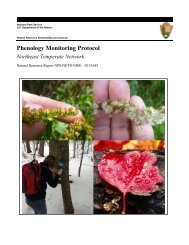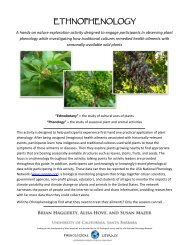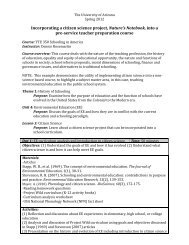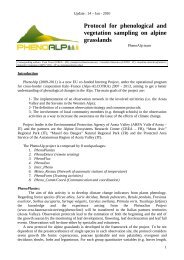The Phenology Handbook - USA National Phenology Network
The Phenology Handbook - USA National Phenology Network
The Phenology Handbook - USA National Phenology Network
You also want an ePaper? Increase the reach of your titles
YUMPU automatically turns print PDFs into web optimized ePapers that Google loves.
Phenological monitoring is facilitated by first noting two features of all flowering plants:<br />
• Floral architecture or inflorescence type - are flowers clustered in inflorescences, or are they<br />
borne singly?<br />
• Habit - is the plant herbaceous (non-woody) or woody? Is the plant a shrub or a tree?<br />
FLOWERING ARCHITECTURE<br />
Whether a plant produces solitary flowers or inflorescences will change the way that flowering phenophases are<br />
determined and recorded. See the Phenophase Quick-Guide and the list below to examine these effects. Below<br />
are illustrations of the major inflorescence types that you are likely to encounter. Once you identify the inflorescence<br />
type of your targeted species, simply find the appropriate cell in the Quick-Guide to find the quick<br />
definition of each leafing or flowering phenophase.<br />
To help orient you when examining flowers on an unfamiliar plant, the following illustrations show a variety of<br />
floral displays you may encounter. Compare the illustrations to the photos in the “Field Guide to Coal Oil Point<br />
Natural Reserve” in this <strong>Handbook</strong>, and to photos in other field guides, to feel more comfortable in the field.<br />
To help simplify your experiences in the field we have categorized inflorescences by general appearance. Once<br />
you identify the inflorescence type of your targeted species, simply find the appropriate cell in the Phenophase<br />
Quick-Guide to find the quick definition of each leafing or flowering phenophase.<br />
SOLITARY FLOWERS<br />
Solitary flowers are borne singly on stems. <strong>The</strong> California Poppy, Eschscholzia californica,<br />
is an example.<br />
SPIKE-LIKE INFLORESCENCES<br />
Spike<br />
Elongated inflorescence in which flowers are arranged in a linear manner along<br />
the stem and are attached directly to the main stem (pedicels, or stems connecting<br />
flowers to the stem, are absent). Flowering typically begins at the bast of the<br />
spike and progresses upward.<br />
34










